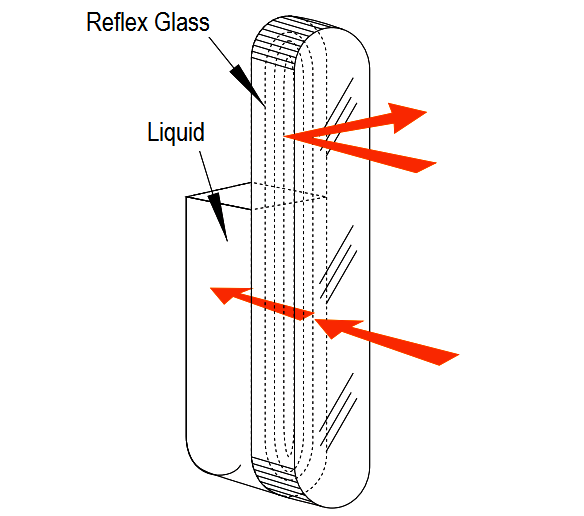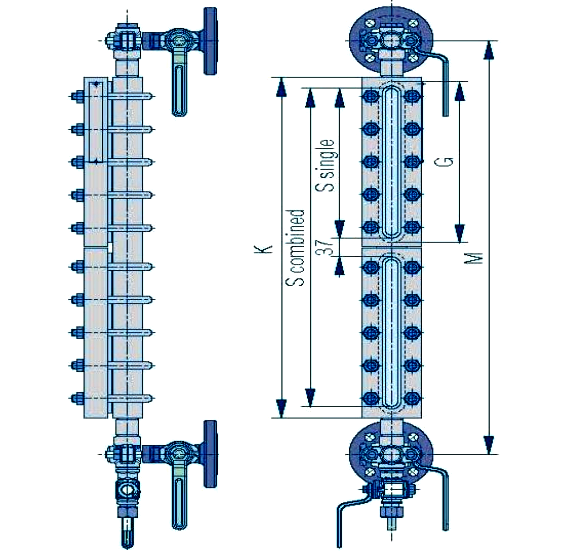Liquid Level Gauge provides direct observation of liquid level in a tank/vessel rising and falling level of the liquid inside the tank/vessel can be observed through the glass assembled in the gauge.
Reflex Level Gauge use the R-form sight glasses. One side surface of Reflex Glass to use flat glass has several grooves for reflecting prism. The principle of the Reflex Glass is based on the difference in the refractive indices of liquid and gas or in particular of water and steam. Liquid level shows conspicuously dark hard colour for liquid space and light white colour for empty space. These Reflex series are not used with a mica shield.
Reflex Level Gauge
The Reflex Gauge is assembled firmly with gasket, reflex glass, cushion gasket and gauge cover on the body by U-bolts. Reflex Liquid Level Gauges, designed and built for a wide range of high temperature and high pressure applications.

The most advantage of this type is for easy level reading of boiling liquids. When liquids are boiling, their bubbles make the surface level indistinct. The manual adjustment of isolation valve at the input of the media entering the chamber reduces the bubbling.
Therefore the level gauge ease to read the level or bubbling liquids. It also provides advantages for highly dense and viscous liquids, as the body is made of forged construction only. This level gauge is designed and manufactured for easy and accurate reading the liquid level of highly foamy liquids. The gauge has a relatively spacious internal area where foamy liquid is held from forming foams.
Reflex Level Gauge Construction
The gauge consists of a body having machined to have a liquid where high temperature are liable to occur, the glass is toughened borosilicate glasses are used.
These reflex gauges preferably used for reservoir tanks that require a relatively long visible length by constructing the supporter. The reflex level gauge is assembled firmly with gasket, reflex glass, cushion gasket and gauge cover on the body by U bolts.

Main Components of Level Gauge
- Chamber: Center of the gauge, and is the part that primarily contains the process fluid. It is machined from bar stock. The gasket seat is recessed for lateral support, and easy positioning.
- Glass: Provides the visual interface between the process fluid and the outside.
- Cover: Protects the glass, and provides the compression surface for sealing the gauge. The cushion seat is surfaced for lateral support and easy positioning.
- Gasket/Cushion: Provides for a seal between the chamber and glass (gasket), and protects the glass from mechanical stresses from the cover (cushion). For a given gauge, the gasket and cushion are normally the same material.
- Bolts/Studs/Nuts: Provides a uniform compression load to the gauge for pressure sealing.
Another advantage of reflex level gauge is that it has no invisible sections (dead band). Standard overlapped section is 10 mm as minimum and the gauge is so designed that supporting brackets can be equipped to protect a long multiple connected gauge from distortion of fall down. The scale plate to mount alongside the gauge may be available on request by customers to observe the liquid level more accurately.
The gauge is used with a special reflex type gauge glass which has wider V-shaped refractive grove and red coating on the outside of the glass. It provides a clear observation of liquid level because of made refracting red colour on th V-groove for steam or beyond portion of the level and it’s colour of fluid itself for liquid portions.
Basic GA drawing indicating the top bottom design with CCD inter face with visible length. The distance between cover plate and bolted bonnet offset construction is 70mm and that of screwed bonnet is 80mm. The glass edge is approx 8mm more in each case against the isolation valve in top bottom design.

Advantages of Reflex Level Gauges
The most advantage of this type is for easy reading of boiling liquids. In the event of liquids boiling, the bubbling make indistinct the surface level. In this type of reflex level gauge with larger volume of the liquid chamber the bubbling will be reduced. This type is also applicable for highly dense and viscous liquid, as the body is made of seamless pipe.
If a conventional level gauge is used for extremely low temperature applications, it becomes difficult to observe the level of liquid as the gauge front tends to freeze. To get rid of this problem, the acrylic non-frosting plate window is mounted in the front of the reflex level gauge to observe the level easily far better.
This type is usually called a jacket type. This gauge is used to read the level of high congealable or ebullient liquids. The principle is to inflow a steam for congealable liquids and a cold water for enbullient liquids through the inside of the jacket to ensure accurate and reliable level observation. This type is used for observing the fluid by changing it into state of liquid after heating or cooling it through jacket according to fluid’s features.



